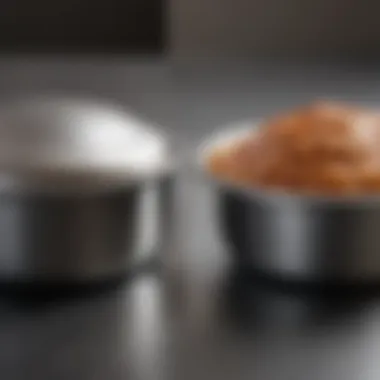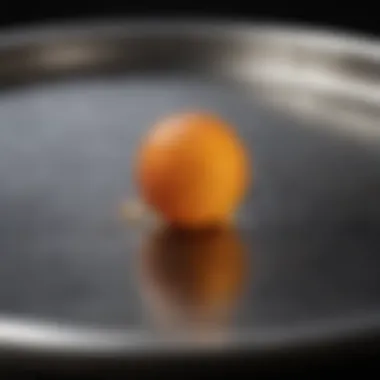Techniques to Remove Fingerprints from Stainless Steel


Intro
Maintaining the pristine allure of stainless steel surfaces can sometimes feel like a losing battle against the constant presence of fingerprints. Whether it’s the sleek fridge in the kitchen or the polished finish of a countertop, these surfaces are susceptible to the greasy touch of fingers, which tend to leave unsightly smudges. Understanding effective methods for cleaning and preserving the shiny surface is essential for any environment where aesthetic appeal is of utmost importance. In this guide, we will thoroughly explore various techniques for eliminating fingerprints from stainless steel, delve into recommended cleaning supplies, and share insights on upkeep and prevention strategies.
Recipe Overview
Brief Description of the Dish
Cleaning fingerprints off stainless steel isn’t exactly akin to whipping up a culinary masterpiece, but it does involve a careful blend of methods and materials to restore that mirror-like finish. Much like selecting the right ingredients in a recipe, choosing the appropriate cleaning solutions and tools will dictate the effectiveness of your efforts.
Key Ingredients
- Microfiber cloths: Soft and effective in lifting dirt without scratching the surface.
- White vinegar: A natural cleanser that cuts through grease.
- Baking soda: Acts as a mild abrasive, ideal for stubborn marks.
- Olive oil (or baby oil): Useful for polishing and leaving a protective sheen.
- Dish soap: A go-to for an initial wash to loosen grime.
Preparation Guidelines
Step-by-Step Instructions
- Start with a clean slate: Before targeting fingerprints, wipe down the stainless steel surface with warm, soapy water to remove initial dirt and grime. Rinse and dry with a clean microfiber cloth.
- Whip up a cleaning solution: For a more targeted approach, mix equal parts of white vinegar and water in a spray bottle. This solution is effective for breaking down the oils that fingerprints leave behind.
- Spray and wipe: Generously apply the vinegar solution onto the stainless steel surface. Using a microfiber cloth, wipe in the direction of the grain. Circular motions can cause streaks, so be mindful.
- For stubborn smudges: Sprinkle a little baking soda on problematic areas. Dampen a cloth with your vinegar solution, and gently rub the area. Rinse and dry afterward.
- Finishing touches: Dampen a clean cloth with a few drops of olive oil. Buff the surface lightly to give it a nice shine and create a barrier against future marks.
Preparation Tips and Tricks
- Regular maintenance: Clean the surfaces at least once a week to prevent build-up.
- Test first: If trying a new cleaner, always spot-test on an inconspicuous area to ensure there will be no adverse effects.
- Avoid abrasive pads: They can scratch and ruin the finish, turning a clean surface into a faded one.
"A little prevention goes a long way in keeping stainless steel spotless. Just like ensuring a well-prepped meal, taking small steps can yield the best outcomes."
Prelims to Stainless Steel Maintenance
Stainless steel is a material that many of us admire for its sleek look and longevity, but maintaining that pristine condition can be a real chore. This article aims to shine a light on the necessity of proper upkeep, especially when it comes to those all-too-familiar fingerprints that appear on these surfaces. Just like any smoothly running kitchen appliance, stainless steel needs regular care to retain its luster and functionality.
Understanding how to properly maintain stainless steel not only enhances its visual appeal but also extends its lifespan. Whether in homes, restaurants, or commercial kitchens, you will find stainless steel fixtures everywhere. The way these surfaces are cared for can make a world of difference, reflecting not just on aesthetics, but also on hygiene.
Understanding Stainless Steel Properties
Stainless steel is an alloy primarily composed of iron, chromium, and nickel, making it resistant to rust and corrosion. This resistance stems from the chromium content, which forms a passive layer of chromium oxide on the surface. This protective layer is what makes stainless steel such a desirable material for kitchens and appliances.
However, this very property can present challenges when it comes to maintenance. The smooth surface, while appealing, tends to show smudges and fingerprints more than one would like to admit. When someone touches the surface, oils and moisture from the skin transfer onto it, leaving behind marks that can be tough to remove if not addressed promptly.
This brings us to the crucial point: understanding the specific properties of stainless steel can help in choosing the right cleaning methods and avoiding common pitfalls during maintenance.
The Challenge of Fingerprints
Fingerprints on stainless steel can be more than just a nuisance; they represent a broader challenge in upkeep. Every little smudge not only detracts from the beauty of the surface but can also harbor bacteria if left to linger. Thus, addressing this issue isn't just about aesthetics—it's also about maintaining a hygienic environment, particularly in areas where food is prepared.
Many might think that simply wiping down surfaces with any cloth will suffice, but that's a common misconception. Using the wrong cleaning tool can lead to scratches, which can then become a breeding ground for dirt. Knowing the right methods can be the difference between a surface that looks clean and one that truly is.
"It’s not just about getting rid of the marks; it’s about using techniques that preserve the integrity of the material along the way."
In the next sections, we will delve into effective techniques for removing these stubborn fingerprints, helping you maintain the impeccable aesthetic of your stainless steel surfaces.
Effective Techniques for Removal
Keeping stainless steel surfaces pristine is no small feat, especially with daily activities illustrating just how fragile their shine can be. The that unmistakable smudge can leave one frustrated, but implements and knowledge of effective techniques for removal can salvage any stainless steel’s appeal. Understanding these techniques isn’t just about aesthetics; it's about maintaining quality and ensuring the longevity of those beloved appliances and fixtures. What follows is a detailed exploration of methods that can be harnessed in the quest for the perfect shine.
Traditional Cleaning Methods
Sometimes, resorting to old-school cleaning methods can be incredibly effective. These approaches are often simple, requiring little more than basic household items and a bit of elbow grease.


Microfiber Cloth Approach
Using a microfiber cloth has become a favorite among cleaning enthusiasts. The unique structure of these cloths allows them to pick up and trap dirt and oils effectively. When tackling fingerprints, a microfiber cloth glides over the stainless steel surface without leaving streaks, which makes it an undeniable star in the toolkit of any cleaner.
Key Characteristic: The ability to lift and trap grime rather than just move it around is what sets these cloths apart. They are also reusable and environmentally friendly.
Some may argue one drawback is the need for occasional laundering; remember, these are tools that should be cared for to maintain their functionalities. Overall, though, for the budget-conscious, this method is both economical and effective.
Soap and Water
When it comes to cleaning, there's something to be said about the classic combination of soap and water. This duo is simple and accessible, perfect for anyone looking to tackle stubborn smudges. A small dish of mild soap mixed with warm water can do wonders.
Key Characteristic: Its universality means almost everyone has these items on hand, making it a go-to method for many.
Despite its usefulness, there’s a downside. If the soap is too harsh or not thoroughly rinsed, it can leave behind its own residue. The importance of proper rinsing can’t be understated—once you think you're done, give that surface a final polish to ensure it shines without any traces left behind.
Using Natural Solutions
For those leaning towards chemical-free solutions, nature has some tricks up its sleeve. Utilizing natural ingredients can be just as effective at getting rid of fingerprints without introducing harsh chemicals that could have adverse effects.
Vinegar and Olive Oil Mixture
This natural concoction has taken the cleaning world by storm. The acetic acid in vinegar cuts through fingerprints effectively while olive oil adds a polish that leaves stainless steel glowing. A simple ratio of one part vinegar to three parts olive oil creates a solution that is surprisingly powerful.
Key Characteristic: As a natural solution, it's safe to use around food and pets, making it a delightful option for kitchens.
While it's a strong contender for cleaning solutions, some might find that a slick residue can remain if too much olive oil is used. Balance is essential here, so it is advisable to buff the surface with a clean, dry cloth after application to achieve that brilliant shine without the greasiness.
Baking Soda Paste
Baking soda is often hailed as a miracle worker in households for good reason. When combined with a little water, it forms a paste that can tackle fingerprints with a hearty scrub. This method is particularly good for surfaces that might have accumulated additional dirt or grime, hence requiring a more abrasive approach without being overly harsh.
Key Characteristic: Non-toxic and safe for the environment, it checks all the boxes for conscientious cleaners.
One minor drawback? Patience may be required, as letting the paste sit for a while before scrubbing can yield better results. Just be sure to rinse thoroughly afterward, as lingering baking soda can create a slightly chalky appearance.
Chemical Cleaners
In a world filled with options, sometimes chemical cleaners step into the spotlight, promising fast results and easy application. However, caution and consideration should guide the use of such products.
Selecting Appropriate Products
Not all cleaners are created equal. It’s crucial to read labels and pick those designed specifically for stainless steel to avoid risk of damage. The right product can wipe away fingerprints in a few effortless swipes, leaving behind a streak-free shine.
Key Characteristic: Convenience is perhaps the strongest selling point, especially for those in a hurry or taking on large cleaning tasks.
However, beware the pitfalls; harsh chemicals can damage the surface over time or emit strong fumes that require protective gear and proper ventilation. Picking safe, trusted brands is a must.
Safety Precautions
While chemical cleaners can achieve impressive results, guarding against their hazards is paramount. Always use them in well-ventilated areas and wear proper gloves to protect skin. Ensuring safety isn’t just a recommendation; it's a necessity when handling chemical products.
Key Characteristic: A focus on caution can significantly reduce potential health risks while cleaning.
Ignoring these precautions can lead to dangerous encounters, including irritation or more severe reactions. Therefore, thorough preparation and mindful application protect not just your appliances but also your well-being.
Specialized Products for Fingerprint Removal


When it comes to maintaining the pristine quality of stainless steel, using specialized products for fingerprint removal can make all the difference. These products not only help in getting rid of those pesky marks but also assist in preserving the overall look and feel of the surface.
Specialized cleaners are formulated specifically for stainless steel. They penetrate the unique finish of the material to lift fingerprints and other residues effectively. This is key because using the wrong product can lead to scratches or a dulled appearance.
Commercial Stainless Steel Cleaners
Features to Look For
When selecting commercial stainless steel cleaners, it's essential to pay attention to certain features that enhance their effectiveness. One of the most critical aspects is the presence of a ** microfiber polishing agent**. This aspect is vital because it provides a gentle scrubbing action while minimizing scratching. Cleaners that boast this feature are highly regarded for their ability to restore shine and clarity.
Another notable characteristic is the ** streak-free formula**. This is beneficial as it ensures that after cleaning, the surface is left spotless, making it look as good as new. Many users prefer products that evaporate quickly to eliminate the risk of residue, which can be a common issue with traditional cleaners. The unique aspect of streak-free formulas is that they often contain solvents designed to aid evaporation, enhancing overall application results.
Application Tips
Proper application of these cleaners maximizes their effectiveness and prolongs the shine of stainless steel. Always start with a soft cloth or towel. Using a microfiber cloth is highly recommended to avoid abrasions. Apply a small amount of cleaner to the cloth rather than directly onto the surface. This prevents over-saturation, which can lead to messiness and poor results.
Another point to consider is the technique: wiping in the direction of the grain is crucial. This approach not only ensures optimal results but also reinforces the natural appearance of the stainless steel surface. In addition, for persistent fingerprints or stains, it’s useful to allow the cleaner to sit for a short while before wiping, giving it time to penetrate. That said, be sure to follow product instructions for any specific timing details, as they can vary.
Government-Recommended Cleaners
Approved Brands
Some cleaners come with the endorsement of safety and effectiveness from government bodies, which can bring peace of mind to consumers. Brands like Method and Bar Keepers Friend frequently receive such approvals thanks to their commitment to sustainability and safety. This attribute gives consumers assurance that these products have undergone rigorous testing.
The distinctive feature of these approved brands is often the plant-based ingredients they use. Not only does this make them eco-friendly, but these ingredients can also be less harsh on the user and the stainless steel itself. This health-conscious choice is becoming increasingly popular among consumers looking to maintain their environment while downkeeping cleanliness.
Usage Guidelines
When using government-recommended cleaners, adhering to usage guidelines is essential for achieving the best results without damaging the surface. Often, these products will have explicit instructions, such as applying on a dry surface for optimum adhesion and effectiveness.
Additionally, it’s beneficial to read any precautions listed, particularly if the cleaner includes chemical solvents. Despite their effectiveness, using them in well-ventilated areas and wearing gloves can prevent potential irritation. As a helpful guideline, familiarize yourself with the specific times and methods deemed effective for these brands, ensuring the longevity of your stainless steel shine.
Preventative Measures to Minimize Fingerprints
Keeping stainless steel surfaces free from fingerprints is a challenge many face. However, adopting preventative measures can significantly reduce the frequency of those pesky smudges. This section outlines a couple of key strategies: applying protective coatings and establishing regular cleaning routines. Both of these methods are integral not only to the upkeep of your stainless steel but also to enhancing its overall appearance and longevity.
Applying Protective Coatings
Waxing Techniques
Waxing stainless steel surfaces is a tried-and-true method that can create a barrier against fingerprints. The main idea is to cover the surface with a thin layer of wax, which helps repel dirt and oils. One of the most notable things about waxing is its ease of application. A simple process requiring a soft cloth and some wax can yield results in no time. Also, a key characteristic of waxing is its ability to give that extra shine, enhancing the look of your stainless steel.
However, it’s essential to choose the right type of wax. Some waxes can leave a greasy residue, while others may wear off quickly. This personal touch provides a beneficial option for maintaining your stainless surfaces, but the trade-off is the potential need for frequent applications.
Clear Coating Options
Clear coatings represent another route to reducing fingerprints on stainless steel. These coatings act as a shield, safeguarding the metal while allowing for a clean look. One highly regarded feature of clear coatings is their durability. Usually made from polymers that bond tightly to the metal, they tend to last longer than wax and require less frequent reapplication. This is particularly advantageous in busy kitchens where wear and tear are common.
Despite the advantages, clear coatings do have a downside. If not applied correctly, they might bubble or peel, creating more problems than they solve. Thus, a thorough application process is paramount. When implemented properly, clear coatings offer a remarkable way to preserve the pristine nature of your stainless steel, cutting down on those stubborn fingerprints.
Regular Cleaning Routines
Scheduled Maintenance
Creating a schedule for cleaning stainless steel surfaces can have lasting benefits. Scheduled maintenance isn’t just about the act of cleaning; it’s about developing consistency. By committing to a routine, you’ll prevent the buildup of oils and fingerprints that tend to accumulate over time. One notable aspect of scheduled maintenance is that it promotes awareness of cleanliness. The more often you clean, the more you become attentive to ways fingerprints materialize.
Additionally, having a plan can make the process less daunting. Whether it’s daily, weekly, or monthly cleaning, sticking to a schedule turns a chore into a manageable task that’s easier to sustain. However, remember that the type of routine you establish should consider your kitchen’s activity level. More cooking means more frequent upkeep.


Recommended Frequency
Now that you understand the importance of having a schedule, let’s discuss what the recommended frequency could be. Depending on usage, many people suggest cleaning stainless steel surfaces at least once a week. This frequency strikes a balance between effort and effectiveness, helping keep fingerprints at bay without turning cleaning into a daily grind.
Using the right cleaner is just as critical as how often you do it. A routine that involves simple, effective cleaning agents can keep things smooth and shiny. On the flip side, neglect can lead to unsightly marks and might require more aggressive cleaning techniques. Therefore, establishing a good frequency ultimately contributes to long-term maintenance and the stunning appearance of your stainless steel.
It's easier to prevent fingerprints than to deal with them once they've settled in. Regular attention will make the cleaning less burdensome overall.
Common Mistakes to Avoid
When it comes to maintaining the pristine look of stainless steel, avoiding common blunders is crucial. The wrong approach not only fails to eliminate fingerprints but may also lead to scratches or other damage that detracts from the metal’s appeal. In this section, we delve into specific mistakes made by many when caring for stainless steel, ensuring readers can sidestep pitfalls that mar their appliances and surfaces, keeping them looking sharp and shiny.
Using Abrasive Materials
One significant error often observed in stainless steel upkeep is utilizing abrasive materials for cleaning. It might seem like a quick fix, but grabbing a scouring pad or similar tools can cause real harm. Stainless steel, while durable, isn’t impervious to scratches. When you use sandpaper-like materials, the fine scratches don’t just show up—they accumulate over time and can make your shiny appliances look dull and worn.
To avoid this mistake, stick to microfiber cloths or soft sponges when wiping down surfaces. These materials gently lift grime and fingerprints without inflicting damage. Always remember, gentleness is the name of the game. Here’s a quick list of acceptable and unacceptable cleaning tools for stainless steel:
- Acceptable:
- Unacceptable:
- Microfiber cloths
- Soft sponges
- Non-abrasive pads
- Steel wool
- Scouring pads
- Abrasive sprays
By steering clear of abrasive materials, you not only preserve the luster of your stainless steel but also extend its lifespan. A little caution goes a long way!
Ignoring Manufacturer Guidelines
Another mistake many individuals make is neglecting manufacturer guidelines when it comes to cleaning products and methods. Most stainless steel appliances and fixtures come with care instructions tailored to their specific finishes and treatments. Ignoring these guidelines can lead to using incompatible cleaning agents that can either strip away protective coatings or react unfavorably with the surface.
For instance, some cleaners may contain chemicals that are too harsh for stainless steel, causing discoloration or pitting. Before grabbing that multipurpose cleaner, take a moment to check the manufacturer’s instructions. Most brands offer detailed dos and don’ts that are worth their weight in gold.
To sum it up, here’s a brief rundown of what to do:
- Read the manufacturer's care guide.
- Choose cleaning solutions that are specifically recommended.
- Follow application techniques as described by the manufacturer.
Being attentive to these details not only aids in effectively cleaning stainless steel but also enhances its appearance and functionality.
"A little prep can save you a lot of trouble in the long run—always heed expert advice!"
Ultimately, honing in on these common mistakes can dramatically change the upkeep journey of stainless steel surfaces. By choosing the right tools and following specific instructions, you can maintain a flawless finish that remains the envy of all.
End: Mastering Stainless Steel Care
Maintaining the pristine look of stainless steel is no small feat, especially for those who value aesthetics in their kitchens and workspaces. Throughout this article, we have explored a range of techniques aimed at eliminating fingerprints while preserving the surface’s allure. Understanding the steps to care for stainless steel is crucial not just for the visual appeal but also for the longevity and durability of these surfaces.
The complexity surrounding the maintenance of stainless steel arises from the delicate balance between effective cleaning and avoiding damage to the material. The techniques highlighted encompass the spectrum from traditional methods using simple materials to specialized cleaning products, each serving a purpose tailored to different scenarios.
Key considerations involve not only how to clean but also how to prevent those pesky fingerprints from becoming a recurring issue in the first place. Applying protective coatings and sticking to scheduled cleaning routines can make a world of difference, significantly reducing the labor associated with maintenance.
Remember, a little prevention goes a long way. Keeping stainless surfaces clean is less about constant scrubbing and more about understanding how to shield these surfaces from the elements that tarnish their shine.
A masterful approach to stainless steel care ultimately hinges on knowledge and vigilance. It’s a process that rewards consistent effort and pays off in the form of surfaces that not only look good but also last a lot longer than those neglected.
Recap of Key Techniques
To sum it up, here are some pivotal techniques we discussed:
- Microfiber Cloth Approach: Always opt for a high-quality microfiber cloth that captures grease and dirt without scratching.
- Natural Solutions: Mixtures like vinegar and olive oil serve as excellent alternatives to chemical cleaners, providing safe, eco-friendly cleaning options.
- Commercial Cleaners: Choose products specifically designed for stainless steel, checking for features like non-toxic formulas and effective streak-fighting capabilities.
- Protective Coatings: Consider waxing or clear coatings that shield surfaces against fingerprints and water spots.
- Regular Maintenance Routines: Establish a cleaning schedule; consistency is key to keeping stainless steel surfaces looking their best.
Final Thoughts on Maintenance
In the grand scheme of culinary enjoyment, the aesthetic appeal of your kitchen shouldn’t be overlooked. Fingerprints can be seen as a minor annoyance but can easily distract from the beauty of your stainless steel appliances. The techniques we've covered are tailored to fit various lifestyles and preferences, allowing everyone to find an approach that works for them.
Taking the time to implement these strategies will not only enhance the look of your kitchen and dining areas but also ensure that your stainless steel pieces remain in pristine condition for the long haul. Remember, the goal is a kitchen that gleams, not just with the shine of high-quality fixtures but also with the love of good food and community shared around it.







